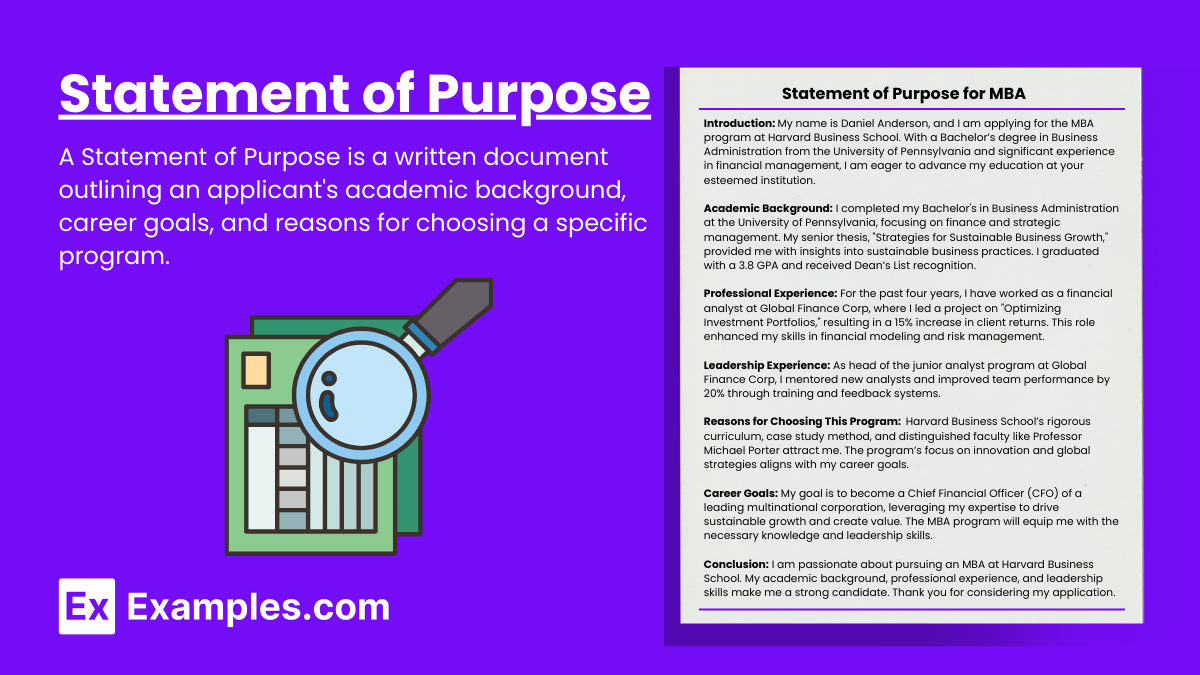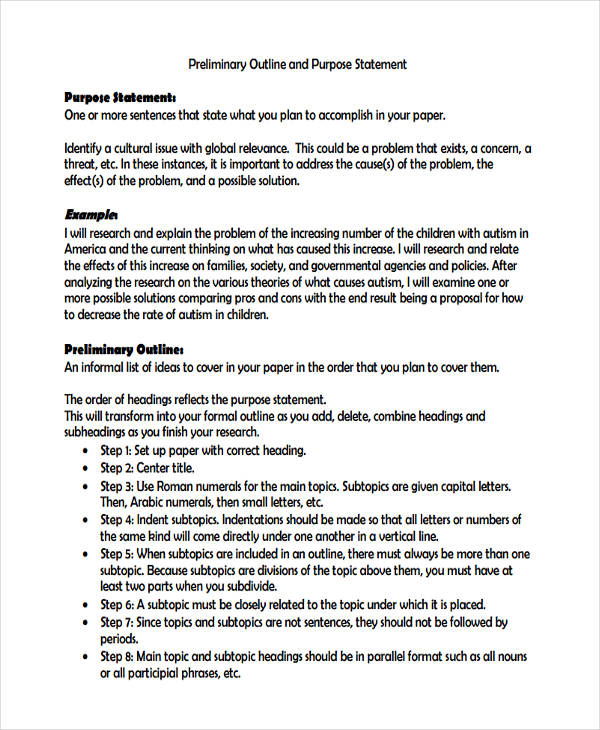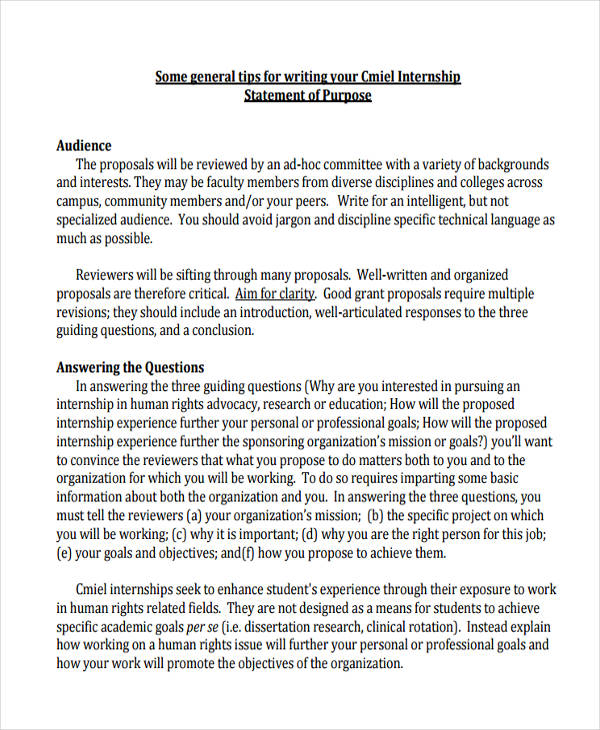10+ Statement of Purpose Examples to Download
Statements are often used in expressing information about a certain subject. People rely on statement in informing a certain audience what they need to know about a specific topic. For example, vision statements inform people about the long term and short term goals and targets of a certain company or business.
Thus, it can be concluded that businesses usually count on statements in the dissemination of important information to their clients. A beneficiary simple statement, for instance, is usually given by a lender to a borrower, disclosing the remaining unpaid balance of a loan as of a certain period, including the interest rate.
What Is a Statement of Purpose?
A Statement of Purpose (SOP) is a written document typically required for university applications. It outlines an applicant’s academic background, professional experiences, career goals, and reasons for choosing a particular program. An effective SOP highlights the applicant’s strengths and unique qualities, demonstrating their fit for the desired program and their potential for success.
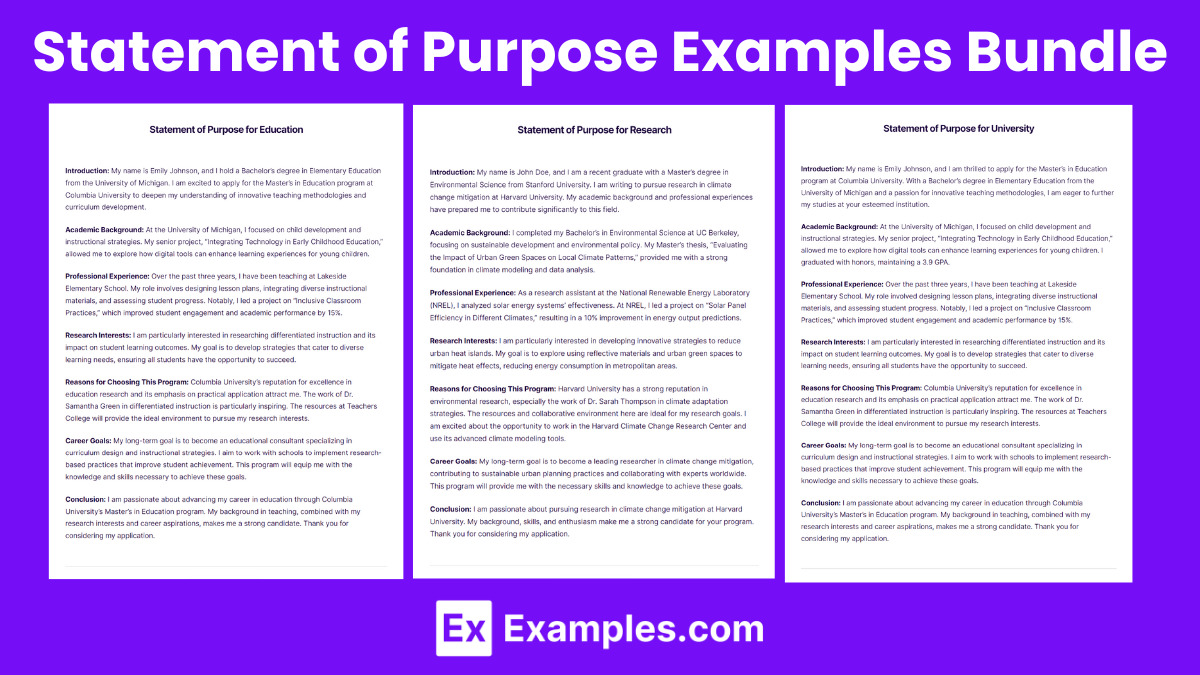
Download Statement of Purpose Bundle
Statement of Purpose Format
A Statement of Purpose (SOP) is a crucial document for academic or professional applications. It outlines your goals, motivations, and qualifications. Here’s a suggested format for writing an effective SOP:
1. Introduction
Opening Paragraph: Start with a strong opening sentence to grab attention. Introduce yourself, mention the program or position you are applying for, and state your main goal.
Example: “As a passionate computer scientist with a keen interest in artificial intelligence, I am excited to apply for the Master’s program in Computer Science at XYZ University.”
2. Academic Background
Educational History: Briefly describe your academic background, focusing on relevant degrees, courses, and projects.
Example: “I completed my Bachelor’s degree in Computer Science at ABC University, where I graduated with honors. My coursework included advanced algorithms, machine learning, and data structures.”
3. Professional Experience (if applicable)
Work Experience: Outline your professional experience, emphasizing roles, responsibilities, and achievements related to your field of study or career goals.
Example: “After graduation, I worked as a software engineer at TechCorp, where I developed machine learning models for predictive analytics, improving accuracy by 20%.”
4. Research Experience (if applicable)
Research Projects: Detail any research projects you have undertaken, including your role, the project’s scope, and the outcomes.
Example: “During my undergraduate studies, I conducted research on neural networks, resulting in a publication in the International Journal of Computer Science.”
5. Relevant Skills and Achievements
Skills and Certifications: Highlight key skills, certifications, and any awards or recognitions you have received.
Example: “I am proficient in Python, Java, and R, and have earned certifications in Data Science and AI from Coursera. I was also awarded the Dean’s Scholarship for academic excellence.”
6. Goals and Objectives
Short-term and Long-term Goals: Clearly state your short-term and long-term goals and how the program or position will help you achieve them.
Example: “In the short term, I aim to deepen my knowledge of AI through advanced coursework and research. Long-term, I aspire to lead AI projects in the healthcare sector to improve diagnostic accuracy.”
7. Why This Program/Institution
Fit with the Program/Institution: Explain why you chose this particular program or institution, highlighting specific faculty members, courses, facilities, or values that attract you.
Example: “I am particularly drawn to XYZ University’s AI research lab and the opportunity to work with Professor Smith, whose work on neural networks aligns with my interests.”
8. Conclusion
Closing Paragraph: Summarize your enthusiasm for the program and reiterate your readiness to contribute and grow.
Example: “I am confident that the Master’s program at XYZ University will provide me with the knowledge and skills to achieve my goals. I look forward to the opportunity to contribute to and learn from your esteemed institution.”
Statement of Purpose Examples
- Statement of Purpose for Research
- Statement of Purpose for Education
- Statement of Purpose for Job
- Statement of Purpose for University
- Statement of Purpose for Engineering
Statement of Purpose for Research
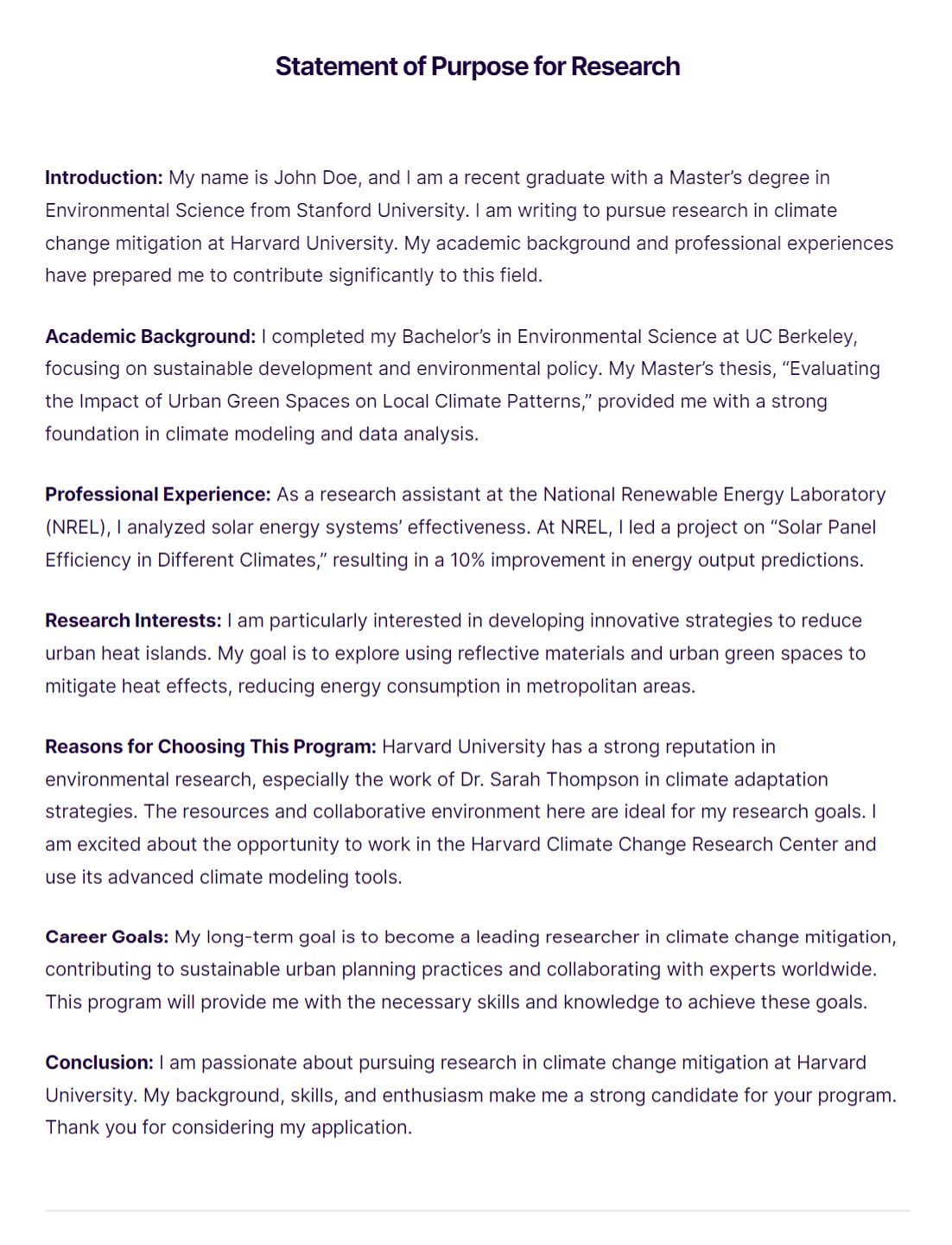
Statement of Purpose for Education
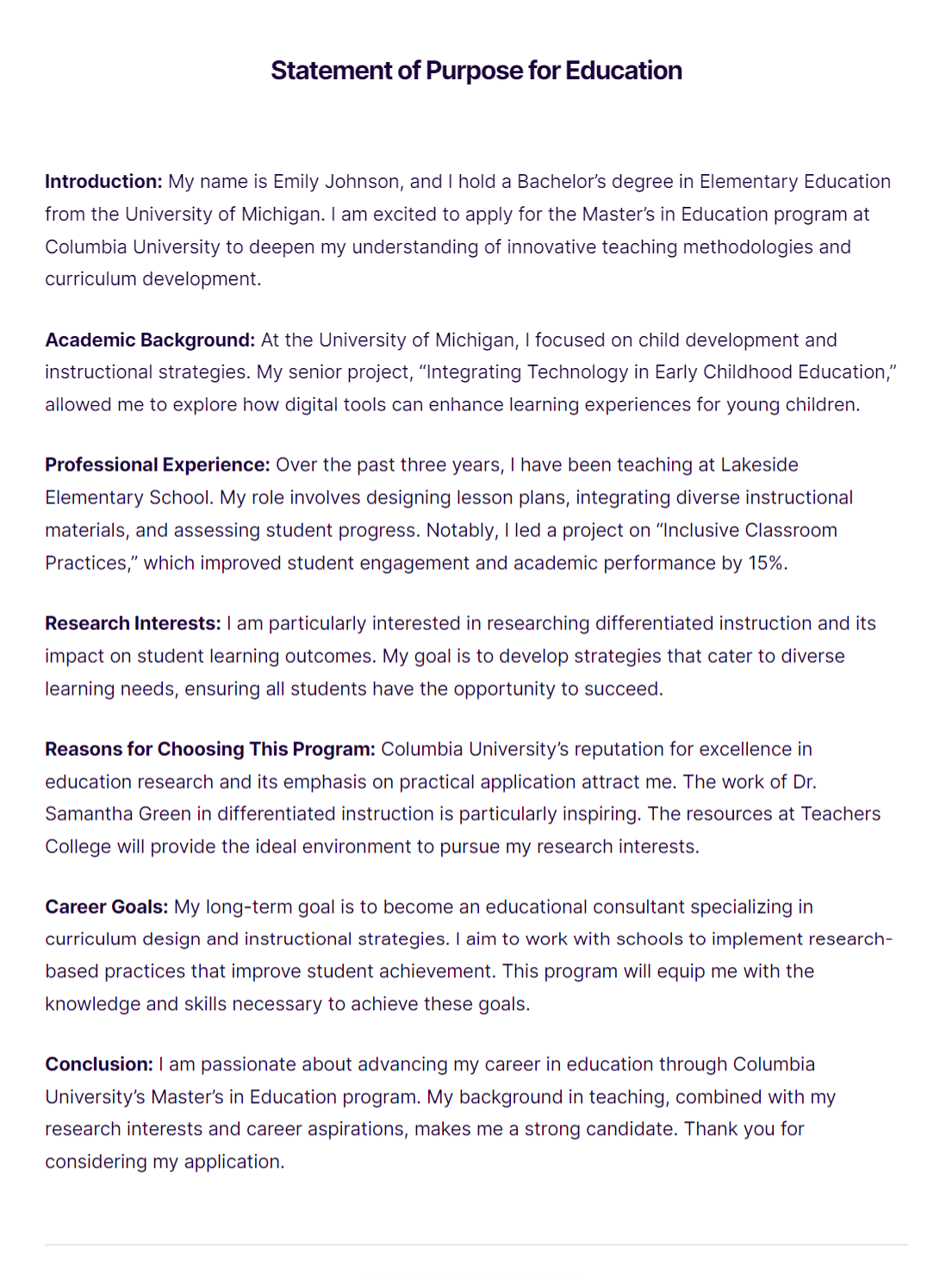
Statement of Purpose for Job
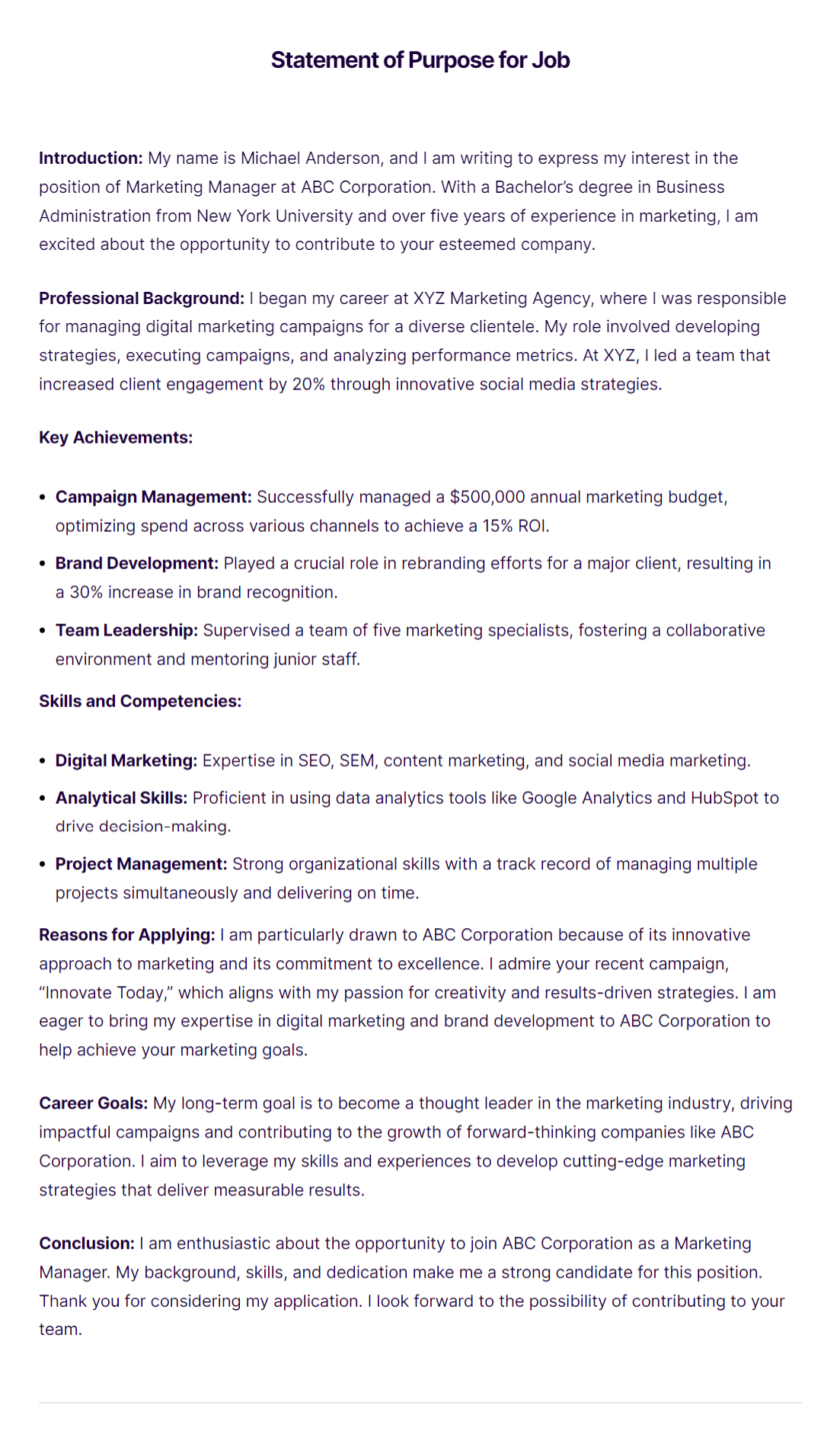
Statement of Purpose for University
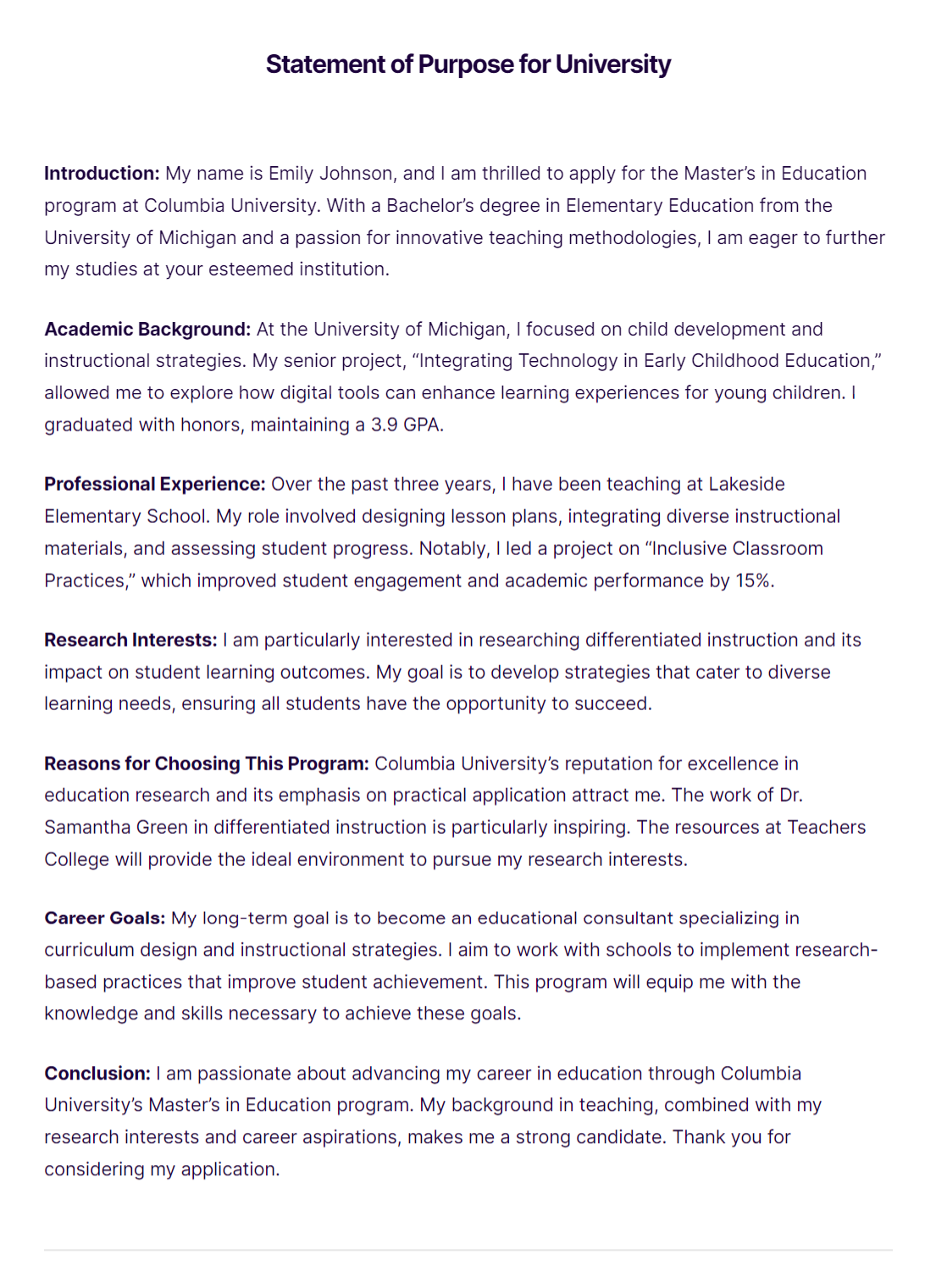
Statement of Purpose for Engineering

More Examples for Statement of Purpose
- Statement of Purpose for Masters
- Statement of Purpose for Graduate School
- Statement of Purpose for Computer Science
- Statement of Purpose for Biology
- Statement of Purpose for Data Science
- Statement of Purpose for Mba
More Statement of Purpose Templates & Samples
Statement of Purpose Template
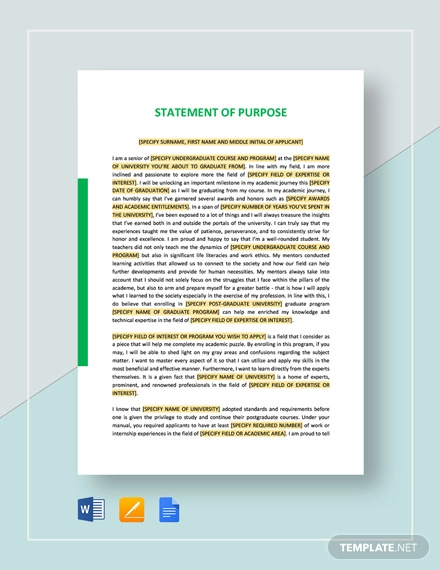
Statement of Purpose Sample

Teaching Statement Example
Outline for Statement of Purpose
Professional Statement Sample
Statement of Purpose for Internship
Dos and Don’ts for Writing a Statement of Purpose
Writing a Statement of Purpose (SOP) is a critical part of the application process for academic programs and professional positions. Here are some essential dos and don’ts to guide you:
Dos for Writing a Statement of Purpose
- Do Be Clear and Concise:
- Keep It Focused: Stick to relevant experiences and information. Avoid unnecessary details.
- Clarity: Ensure each paragraph flows logically and is easy to understand.
- Do Personalize Your SOP:
- Tailor to the Program: Highlight why you are interested in the specific program or institution.
- Specific Examples: Use personal experiences and achievements to demonstrate your fit and passion.
- Do Highlight Your Achievements:
- Showcase Accomplishments: Mention relevant academic, professional, and extracurricular achievements.
- Quantify When Possible: Use numbers or specifics to illustrate your accomplishments (e.g., “improved efficiency by 20%”).
- Do Explain Your Goals:
- Short-term and Long-term Goals: Clearly state your academic and career objectives and how the program will help you achieve them.
- Connection: Show how the program’s offerings align with your goals.
- Do Be Honest and Authentic:
- True Representation: Be genuine about your experiences and aspirations. Authenticity resonates more than embellishment.
- Personal Voice: Write in a natural, personal tone while maintaining professionalism.
- Do Proofread and Edit:
- Check for Errors: Thoroughly proofread for grammar, spelling, and punctuation errors.
- Seek Feedback: Have someone else review your SOP to catch mistakes you might have missed.
- Do Follow Instructions:
- Adhere to Guidelines: Follow any specific instructions regarding length, format, and content provided by the institution or program.
Don’ts for Writing a Statement of Purpose
- Don’t Use Generic Statements:
- Avoid Clichés: Steer clear of overused phrases like “I have always wanted to…” or “Since I was a child…”.
- Be Specific: Provide concrete examples instead of vague generalizations.
- Don’t Repeat Your Resume:
- No Redundancy: Your SOP should complement your resume, not duplicate it. Focus on the narrative behind your achievements.
- Add Depth: Use the SOP to elaborate on key points and provide context.
- Don’t Exaggerate or Lie:
- Be Honest: Misrepresenting your qualifications or experiences can lead to serious consequences.
- Authenticity Over Perfection: It’s better to present a genuine but less-than-perfect story than a fabricated one.
- Don’t Overuse Technical Jargon:
- Simplicity: While demonstrating your knowledge is important, avoid excessive use of technical terms that might confuse the reader.
- Clarity: Ensure your SOP is understandable to non-specialists as well.
- Don’t Focus Solely on Academics:
- Holistic Approach: Include relevant extracurricular activities, volunteer work, and personal experiences that contribute to your suitability for the program.
- Personal Attributes: Highlight qualities like leadership, teamwork, and problem-solving skills.
- Don’t Neglect the Future:
- Goals Matter: Don’t just focus on past achievements; explain how the program will help you achieve your future goals.
- Forward-thinking: Show your vision for how you plan to use the knowledge and skills gained from the program.
- Don’t Write a Generic SOP:
- Customize for Each Application: Avoid using the same SOP for multiple applications. Tailor each one to the specific program and institution.
- Unique Aspects: Mention specific faculty members, courses, or resources that attract you to the program.
Statement of Purpose vs. Personal Statement
| Criteria | Statement of Purpose (SOP) | Personal Statement |
|---|---|---|
| Focus | Academic and professional goals | Personal experiences and motivations |
| Content | Academic background, career objectives, reasons for program choice | Personal background, challenges faced, individual growth |
| Tone | Formal and objective | Narrative and subjective |
| Length | Typically 1-2 pages | Typically 1-2 pages |
| Structure | Structured with clear sections (Introduction, Background, Goals, Conclusion) | More flexible, can be story-like |
| Purpose | To demonstrate fit for the program and professional aspirations | To provide insight into personality, character, and personal journey |
| Details | Specific achievements, projects, and academic interests | Personal anecdotes, life experiences, and formative events |
| Audience | Admissions committee assessing academic potential | Admissions committee seeking to understand personal qualities |
| Examples of Use | Graduate school applications, research programs | Undergraduate applications, scholarships |
| Key Points | Emphasizes future goals and professional path | Highlights personal history and individual motivations |
How to Write a Statement of Purpose
Writing a Statement of Purpose (SOP) involves several key steps to ensure it effectively communicates your motivations, qualifications, and aspirations. Here’s a step-by-step guide:
Step-by-Step Guide to Writing a Statement of Purpose
1. Understand the Purpose
- Objective: Know that an SOP is meant to explain your academic and professional journey, your goals, and why you are applying to a specific program or position.
2. Research the Program or Position
- Specifics: Research the institution or company, the specific program or role, its culture, faculty members, courses, and any special projects or opportunities they offer.
3. Outline Your SOP
- Structure: Create an outline to organize your thoughts and ensure you cover all necessary sections.
4. Write the Introduction
- Engage: Start with a compelling introduction that grabs the reader’s attention. Mention who you are, what you are applying for, and a brief overview of your main goal.
- Example: “With a deep-seated passion for environmental science and sustainability, I am excited to apply for the Master’s program in Environmental Science at ABC University.”
5. Detail Your Academic Background
- Highlight: Summarize your academic journey, focusing on relevant degrees, courses, and academic achievements.
- Example: “I graduated with a Bachelor’s degree in Environmental Science from XYZ University, where I developed a strong foundation in ecological research and environmental policy.”
6. Discuss Professional Experience (if applicable)
- Experience: Outline your professional experience, focusing on roles, responsibilities, and achievements relevant to the program or position.
- Example: “In my role as an environmental analyst at Green Solutions, I led a project that reduced carbon emissions by 15%, demonstrating my ability to apply theoretical knowledge to practical challenges.”
7. Highlight Research Experience (if applicable)
- Projects: Describe any significant research projects, your role in them, and their outcomes.
- Example: “During my undergraduate studies, I conducted research on renewable energy sources, which culminated in a published paper in the Journal of Environmental Studies.”
8. List Relevant Skills and Achievements
- Skills: Mention key skills, certifications, and notable achievements.
- Example: “I am proficient in GIS mapping, data analysis, and have completed certifications in sustainable development and climate change.”
9. State Your Goals and Objectives
- Goals: Clearly articulate your short-term and long-term goals and how the program or position will help you achieve them.
- Example: “My short-term goal is to deepen my expertise in environmental science through advanced coursework and research. Long-term, I aspire to influence environmental policy and contribute to sustainable development initiatives globally.”
10. Explain Your Choice of Program/Institution
- Fit: Explain why you chose this specific program or institution, referencing particular faculty members, courses, or resources that align with your interests and goals.
- Example: “I am particularly drawn to ABC University’s renowned environmental science department and the opportunity to work with Professor Jane Doe, whose research on sustainable agriculture aligns with my interests.”
11. Conclude with Enthusiasm
- Wrap Up: End with a strong conclusion that reiterates your enthusiasm and readiness for the program or position.
- Example: “I am confident that the Master’s program at ABC University will provide me with the knowledge and skills necessary to achieve my career aspirations. I look forward to the opportunity to contribute to and grow with your esteemed institution.”
12. Review and Revise
- Proofread: Carefully proofread your SOP for grammar, spelling, and clarity. Revise it to ensure it is coherent, concise, and compelling.
What is a Statement of Purpose (SOP)?
An SOP is a written document detailing an applicant’s academic background, professional goals, and reasons for choosing a specific program or institution.
Why is an SOP important?
It helps admissions committees assess your fit for the program, understand your motivations, and evaluate your potential for success.
What should be included in an SOP?
Include your academic background, professional experiences, career goals, reasons for applying, and why you chose the specific program and institution.
How long should an SOP be?
Typically, an SOP is 1-2 pages long, adhering to the word limit specified by the program or institution.
Can I use the same SOP for different applications?
It’s best to tailor each SOP to the specific program and institution, highlighting unique features and your fit for each one.
How should I structure my SOP?
Use a clear structure with sections for Introduction, Academic Background, Professional Experience, Reasons for Applying, Career Goals, and Conclusion.
What tone should I use in my SOP?
Maintain a formal yet engaging tone, demonstrating professionalism and genuine interest in the field of study.
How do I make my SOP stand out?
Be specific about your achievements and experiences, provide concrete examples, and show enthusiasm for the program.
Should I mention weaknesses in my SOP?
It’s generally better to focus on strengths and how you’ve overcome challenges, rather than highlighting weaknesses.
Can I include personal anecdotes in my SOP?
Yes, but ensure they are relevant to your academic and professional goals, and they contribute to your overall narrative.



